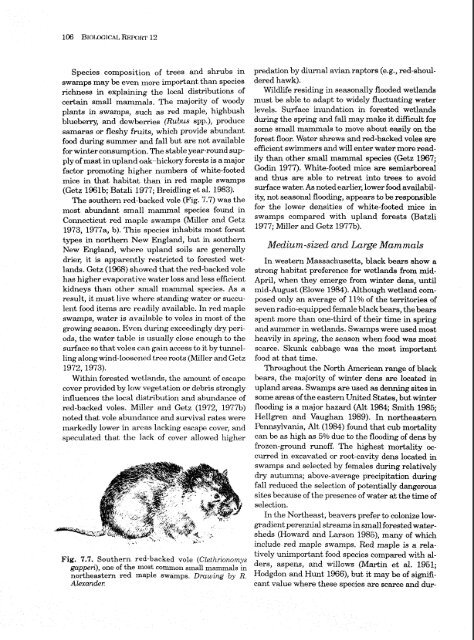Ecology of Red Maple Swamps in the Glaciated Northeast: A ...
Ecology of Red Maple Swamps in the Glaciated Northeast: A ...
Ecology of Red Maple Swamps in the Glaciated Northeast: A ...
You also want an ePaper? Increase the reach of your titles
YUMPU automatically turns print PDFs into web optimized ePapers that Google loves.
Species composition <strong>of</strong> trees and shrubs <strong>in</strong><br />
swamps may be even more important than species<br />
richness <strong>in</strong> eqla<strong>in</strong>irlg <strong>the</strong> local distributions <strong>of</strong><br />
certa<strong>in</strong> small mammals. me majority <strong>of</strong> woody<br />
plants <strong>in</strong> swamps, such as red maple, highbush<br />
blueberry, and dewberries (Rubus spp.), produce<br />
samaras or fleshy fruits, which provide abundant<br />
food dur<strong>in</strong>g summer and fall but are not available<br />
for w<strong>in</strong>ter consumption. The stable year-round supply<br />
<strong>of</strong> mast <strong>in</strong> upland oak-hickory forests is a major<br />
factor promot<strong>in</strong>g higher numbers <strong>of</strong> white-footed<br />
mice <strong>in</strong> that habitat than <strong>in</strong> red maple swamps<br />
(Getz 1961b; Batzli 1977; Breidl<strong>in</strong>g et al. 1983).<br />
The sou<strong>the</strong>rn red-backed vole (Fig. 7.7) was <strong>the</strong><br />
most abundant small mama1 species found <strong>in</strong><br />
Connecticut red maple swamps (Miller and Getz<br />
1973, 1977a, b). This spies <strong>in</strong>habits most forest<br />
types <strong>in</strong> nor<strong>the</strong>m New England, but <strong>in</strong> sou<strong>the</strong>rn<br />
New England, where upland soils are generally<br />
drier, it is apparexxtly restricted to forested wetland~.<br />
GGtz (1%) showed that <strong>the</strong> red-backed vole<br />
hm higher evaporative water loss and less efficient<br />
kidx~eys than o<strong>the</strong>r srnall mammal species. As a<br />
result,, it must live where stand<strong>in</strong>g wabr or succulent<br />
foot5 items are readily available. In red maple<br />
swamps, water is ~vaililblr voles <strong>in</strong> most <strong>of</strong> <strong>the</strong><br />
growixlg season. Even dur<strong>in</strong>g exceed<strong>in</strong>g1 y dry peri-<br />
ods, title water t.zrLle is rls~~ally close enough to <strong>the</strong><br />
surface so that VOICR call gn<strong>in</strong> access to it by tuxulell<strong>in</strong>g<br />
along w<strong>in</strong>d-lcmseucd t,rcae roots (hfiller and Getz<br />
1972, 1973).<br />
Witll<strong>in</strong> forested wc~t,lrtntfs, <strong>the</strong> amount, <strong>of</strong> escape<br />
cover provided by low vegc:tation or debris strongly<br />
<strong>in</strong>fluerxces tXxc; local. distribution and abundance <strong>of</strong><br />
red-backed voles. Miller and Cetz (1972, 1977b)<br />
noted that vole abundance and survival rates were<br />
nlcprkc.&y lower <strong>in</strong> arcas lack<strong>in</strong>g escape cover, and<br />
speculated that time lack <strong>of</strong> cover allowed higher<br />
predation by diurnal avian raptors (e.g., red-shoddered<br />
hawk).<br />
Wildlife resid<strong>in</strong>g <strong>in</strong> seasonally flooded wetlands<br />
must be able to adapt to widely fluctuat<strong>in</strong>g water<br />
levels. Surface <strong>in</strong>undation <strong>in</strong> forested wetlands<br />
dur<strong>in</strong>g <strong>the</strong> spr<strong>in</strong>g and fall may make it difficult for<br />
some srnall mammals to move about easily on <strong>the</strong><br />
forest floor. Water shrews and red-backed voles are<br />
efficient swimmers and will enter water more readily<br />
than o<strong>the</strong>r small mammal species (Getz 1967;<br />
God<strong>in</strong> 1977). White-footed mice are semiarboreal<br />
and thus are able to retreat <strong>in</strong>to trees to avoid<br />
surface water. As noted earlier, lower food availability,<br />
not seasonal flood<strong>in</strong>g, appears to be responsible<br />
for <strong>the</strong> lower densities <strong>of</strong> white-footed mice <strong>in</strong><br />
swamps compared with upland forests (Batzli<br />
1977; Miller and Getz 1977b).<br />
Medium-sized and Large Mammals<br />
In western Massachusetts, black bears show a<br />
strong habitat preference for wetlands from mid-<br />
April, when <strong>the</strong>y emerge from w<strong>in</strong>ter dens, until<br />
mid-August (Elowe 1984). Although wetland composed<br />
only an average <strong>of</strong> 11% <strong>of</strong> <strong>the</strong> territories <strong>of</strong><br />
seven radio-equipped female black bears, <strong>the</strong> bears<br />
spent more than one-third <strong>of</strong> <strong>the</strong>ir time <strong>in</strong> spr<strong>in</strong>g<br />
and summer <strong>in</strong> wetlands. <strong>Swamps</strong> were used most<br />
heavily <strong>in</strong> spr<strong>in</strong>g, <strong>the</strong> season when food was most<br />
scarce. Skunk cabbage was <strong>the</strong> most important<br />
food at that time.<br />
Throughout <strong>the</strong> North American range <strong>of</strong> black<br />
bears, <strong>the</strong> majority <strong>of</strong> w<strong>in</strong>ter dens are located <strong>in</strong><br />
upland areas. <strong>Swamps</strong> are used as denn<strong>in</strong>g sites <strong>in</strong><br />
some areas <strong>of</strong> <strong>the</strong> eastern United States, but w<strong>in</strong>ter<br />
flood<strong>in</strong>g is a major hazard (Alt 19W, Smith 1985;<br />
Hellgren and Vaughan 1989). In nor<strong>the</strong>astern<br />
Pennsylvania, Alt (1984) found that cub mortality<br />
can be as high as 5% due to <strong>the</strong> flood<strong>in</strong>g <strong>of</strong> dens by<br />
frozen-ground run<strong>of</strong>f. The highest mortality occurred<br />
<strong>in</strong> excavated or root-cavitv dens located <strong>in</strong><br />
swamps and selected by females dur<strong>in</strong>g relatively<br />
dry autumns; above-average precipitation dur<strong>in</strong>g<br />
fall reduced <strong>the</strong> selection <strong>of</strong> potentially dangerous<br />
sites because <strong>of</strong> <strong>the</strong> presence <strong>of</strong> water at <strong>the</strong> time <strong>of</strong><br />
selection.<br />
In <strong>the</strong> Nor<strong>the</strong>ast, beavers prefer to colonize lowgradient<br />
perennial streams <strong>in</strong> small forested watersheds<br />
(Iloward and Larson 1985), many <strong>of</strong> which<br />
<strong>in</strong>clude red maple swamps. <strong>Red</strong> maple is a relatively<br />
unimportant fwd species compared with al-<br />
Fig. 7.7. Sou<strong>the</strong>rn red-backed vole (Ckihrionomys ders, aspens, and wiliows<br />
gapperi), one <strong>of</strong> <strong>the</strong> most ccmmon small mammals <strong>in</strong><br />
et 1951;<br />
nodheastern red maple swamps. Draw<strong>in</strong>g by R. Hodgdon and I-%unt 19661, but it may be <strong>of</strong> signifz-<br />
Alexander:<br />
cant vdue where <strong>the</strong>se species are scarce and dur-

















